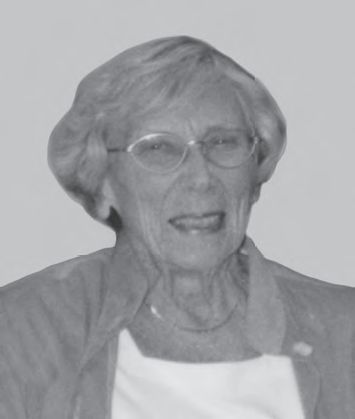
Physiology News Magazine
Obituary: Maureen Young
1915 – 2013
Membership
Obituary: Maureen Young
1915 – 2013
Membership
Abigail Fowden
https://doi.org/10.36866/pn.93.54

Maureen Young was born on 16 October 1915 in Southwold, Suffolk, England. Her mother, Ina Heslop, was Irish and her father, William Young, was English. They met in Dover where Ina was nursing the sick and wounded of World War I and William was a doctor waiting to embark for service in France. Her early childhood was spent with her younger brother in London where her father was a pathologist at Guy’s Hospital after the war. When she was ten, her parents moved to a posting in Singapore and she was sent to boarding school, Northwood Girls School, where practical lessons in chemistry and biology awakened her interest in science. Her father was keen that girls should be educated and financially secure so he was happy to pay the fees for Maureen to attend Bedford College for women when she finished at school.
Maureen was a student at Bedford College from 1932 to 1938, a long period as an undergraduate by today’s standards. First, she had to take an intermediate year in chemistry, physics, botany and zoology as she had not taken higher qualification examinations at school. When she failed physics at the end of the first year, she had to repeat the year. She then proceeded to a three-year general degree in physiology, chemistry and zoology followed by a one-year special degree in physiology, graduating with 2nd class BSc (Special) in 1938. For the summer vacations of both 1937 and 1938, Maureen went to Germany to learn German, an essential language for scientists then, and saw firsthand the Nazi preparations for war. In the early years of WWII, Maureen worked with the Blood Transfusion Service, based partly in at St Thomas’ Hospital, helping to develop an acid-citrate glucose solution for the storage of whole blood. These studies led to her first publication in 1940. By 1942 she was back at Bedford College as a demonstrator in physiology, although the College had been evacuated to Cambridge by then. From 1942 to 1945, she therefore worked in the Physiological Laboratory in Cambridge, teaching Bedford College students and carrying out research with Professor Joseph Barcroft. He had been Head of Department of Physiology but by 1942 was in his 70s with failing eyesight. He recruited Maureen to take blood samples from the tiny carotid arteries of fetal rabbits to measure developmental changes in the oxygen content of fetal blood. This initiated Maureen’s life-long interest in fetal physiology.
After the war, Maureen moved to St Thomas’ Hospital as a demonstrator in physiology when the medical schools started to appoint women to the teaching staff with the new compulsory intake of 15% women students. However, despite her previous research experience, it was not considered suitable for her to teach medical students reproductive physiology for several years after her appointment! Over her career at St Thomas’, she taught many aspects of physiology to Second MB medical students and ran an intercalated BSc course, first in the Physiology Department and, then, in the University Department of Obstetrics and Gynaecology (O&G) where she had transferred as a senior lecturer on its formation in 1964. For 18 years, she ran a research unit in O&G at St Thomas’, becoming Professor of Perinatal Physiology before her retirement to a village near Cambridge in 1982. During her career, she had several periods working abroad, at Yale, UCLA, North Western University Chicago and in the Department of Obstetrics in Perth, Australia, which established life-long international collaborations and friendships.
Even after retirement, she continued with research and academic work as a visitor at the Babraham Institute and an associate editor of Placenta.
At St Thomas’, her initial research focused on the placental transfer of curare and other drugs using rabbits and guinea pigs and then on the adaptations to the newborn circulation in collaboration with clinical colleagues. Finally, her interests moved onto fetal growth and nutrition with particular emphasis on placental transfer of amino acids and the role of insulin in fetal protein turnover in a wide range of species including guinea-pigs, rabbits, sheep and horses. She published well over 100 peer-reviewed original papers, many in The Journal of Physiology, as well as reviews and chapters in books, in a publishing career that spanned 63 years from 1940 until she was 88 in 2003. She was an enthusiastic member of several physiological and paediatric societies, being elected to The Physiological Society in 1944. She was a founder member of the Neonatal Society and its President from 1984 to 1987. She regularly attended national and international meetings well into her 80s.
Maureen was a pioneer in many ways. She was one of the first women to secure a teaching position in a medical school. She championed the professional recognition of women in an era when female academics were rare. She was an active advocate of fetal physiology and the need for basic research to underpin advances in medicine. She was a role model for active retirement, enjoying the freedom from teaching and administrative work to continue pursuing scientific questions through her extensive network of collaborators and colleagues. She was also an inveterate traveller, visiting places like Iran, Hong Kong, Russia and Latin America, often alone, long before travel to these places was easy or entirely safe for Western Europeans. She will be remembered for her many kindnesses to younger academics and clinicians and for her infectious enthusiasm for placental and fetal physiology.
The Society also regrets to announce the death of:
Alan Howe, former Halliburton Professor of Physiology at King’s College London
Notices and full obituaries can be found The Society website at www.physoc.org/obituary-notices
